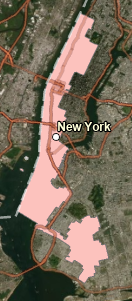Lab 6 [GIS6105]: Interpolation
Estimating the values for chlorophyll a across the tessellated grid using inverse distance weighting (IDW) involved examining the average measurements of chlorophyll a taken from the four sample sites over a two-month window and then weighting these values based on the distance of these sample sites from each grid cell (Bolstad, 2005).
For this case study, I selected parameters for the tessellated surface to create square-shaped grid cells (creating a more uniform visualization for the grid). IDW is a spatial interpolation method well-suited to this application due to the ease of implementation, the speed of the calculation, and the assumption within this case study that the neighborhood of known sites captures relevant local information that should impact each grid cell in the tessellation (i.e., we are assuming no significant outliers). In this example, all sample sites are also in the same waterway, and we are relying on the assumption that there are no barriers to water flow that would suggest weighting each sample site based on any characteristic other than distance is relevant. However, as noted by Boyles and Ramen (2003, pp. 274), if there are any complex topography patterns in this region, other interpolation methods should be investigated for consideration. The search neighborhood could also be narrowed if warranted (e.g., weighting the values from the two closest sampling sites or only considering sampling sites within a specified barrier area).
Challenges encountered in this lab included determining the best visualization in the choropleth map in terms of number of classes. As shown in the final map, the value n=5 was ultimately selected based on the ease of discerning the levels in the yellow to red shading compared to n=7. Five classes also provided sufficient differentiation of the grid values shown in the zoomed image of the lower Bayou Texar region (shown on the right side of the final map). In this image, the grid cells near Sites #3 and #4 are provided in greater detail. This information was used to spot-check the chlorophyll a values near these two sites and was also provided to the map audience given some of the highest values reported in the data set were noted near the popular Bayview Park area.




Comments
Post a Comment